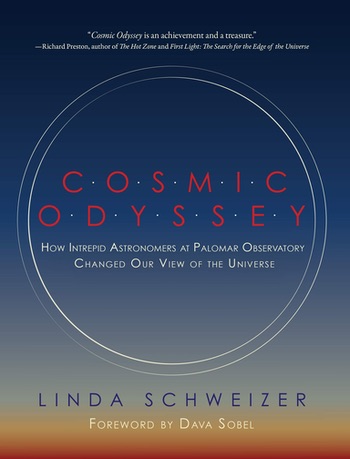Review: Cosmic Odysseyby Jeff Foust
|
| “For quite a while I was on the outside looking in, but I had the advantage that astronomers were tolerant of our exotic experiments, whereas they are ferociously difficult with their own colleagues,” Murray said. |
The light-gathering power of the 200-inch allowed it see dimmer and most distant objects, so much of its work involved studies of distant galaxies. Schweizer covers that work in chapters on topics such as measuring the distances to those galaxies (in the process expanding the size and age of the universe), galactic collisions, and quasars. Within the Milky Way, astronomers used Palomar’s telescopes to better understand stellar evolution and, more recently, look for brown dwarfs.
Studies of solar system objects didn’t get as much attention at Palomar, but wasn’t completely overlooked. Schweizer recounts how Bruce Murray, as a new Caltech postdoc 60 years ago—he would later go on to be director of JPL—secured some state-of-the-art infrared detectors from contacts he had in the military, using them at Palomar to observe Jupiter’s atmosphere. He got time on the 200-inch at the beginning and end of nights, with the “dark time” in the middle of the night reserved for other astronomers. “For quite a while I was on the outside looking in, but I had the advantage that astronomers were tolerant of our exotic experiments, whereas they are ferociously difficult with their own colleagues,” Murray said in an interview with Schweizer.
Many of those astronomers—who Murray also described as “prima donnas” and “egomaniacs”—are featured in the book, from Halton Arp to Fritz Zwicky. They get a kinder treatment from Schweizer, who discusses their personalities alongside their scientific pursuits. One group of British astronomers led by Alexander Boksenberg, who developed an early electronic imaging system, became known as “Boksenberg’s Flying Circus” for taking a light-hearted approach their work in contrast to the “stilted codes of mountain conduct” at Palomar.
Cosmic Odyssey focuses strongly on the science done at Palomar over the decades, rather than the observatory itself. The book addresses much of the history of both Palomar’s development and its changes over the years, but more in passing rather than as a central theme. In the preface, Schweizer describes the many visits she made to Palomar, including seeing some behind-the-scenes work such as cleaning and realuminizing the telescope’s primary mirror. But we don’t get to read as much about how the observatory operates, or how those operations have changed over the years, than we do about its scientific achievements.
Newer, larger telescopes have knocked Palomar from that top tier of observatories it occupied for much of the 20th century, and ever larger telescopes are in development. Palomar, though, remains a productive observatory, incorporating new technologies to support its decades-old telescopes. Its cosmic odyssey will continue for many years.
Note: we are temporarily moderating all comments submitted to deal with a surge in spam.
